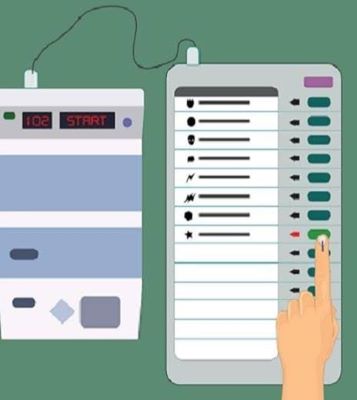Context
The evolution of the voting process has been marked by a transition from traditional paper ballots to the introduction of Electronic Voting Machines (EVMs). Since their inception, EVMs have been a subject of scrutiny, with concerns raised by activists and political parties regarding their reliability and susceptibility to manipulation. Despite the advantages they bring, such as reducing the scope for booth capturing and ensuring faster and more accurate counting, doubts persist about their integrity.
|
What are EVMs? Electronic Voting Machines (EVMs) are devices used for casting votes electronically. They consist of two main components: the control unit and the balloting unit, connected by a cable. The control unit is typically held by the presiding officer or polling officer, while the balloting unit is placed in the voting compartment for voters to cast their votes. This setup ensures that the identity of the voter is verified by the polling officer.
Instead of providing a traditional paper ballot, the EVM displays a list of candidate names and/or symbols on a screen. Each candidate's name or symbol is accompanied by a button, typically colored blue. To cast their vote, the voter simply needs to press the button next to the name or symbol of their chosen candidate. |
History of Voting Process
The journey of democratic elections in India traces back to the early years post-independence when ballot papers were manually marked and dropped into separate boxes for each candidate. Over time, the process evolved, incorporating ballot papers with candidate names and symbols, and eventually introducing Electronic Voting Machines (EVMs) on a trial basis in 1982. The widespread adoption of EVMs in subsequent elections marked a significant shift in the electoral landscape, promising efficiency and accuracy in the voting process. However, this transition has not been devoid of challenges, as evidenced by ongoing debates over the credibility of EVMs.
Concerns Raised by Activists about EVMs
Despite the benefits touted by proponents of EVMs, concerns persist among activists and political entities regarding their vulnerability to tampering and hacking. The most prevalent allegation is that EVMs, being electronic devices, are susceptible to external manipulation, thereby compromising the integrity of the electoral process. While the Election Commission of India (ECI) has repeatedly defended the security measures implemented in EVMs, including their standalone nature and lack of connectivity to external devices, doubts linger, fueled by the absence of foolproof mechanisms to address potential breaches. The demand for greater transparency and accountability in the voting process has underscored the need for reforms to assuage apprehensions and uphold the sanctity of elections.
International Voting Practices
A comparative analysis of voting practices across the globe reveals a diverse landscape, with countries adopting varying methodologies tailored to their unique socio-political contexts. While many western democracies continue to rely on paper ballots for their elections, some have experimented with EVMs before reverting to traditional voting methods. Countries like England, France, and the Netherlands discontinued the use of EVMs for national elections after trials, citing concerns over reliability and security. Conversely, nations like Brazil have embraced EVMs for their electoral processes, highlighting the divergent approaches to election technology. Amidst this global panorama, India grapples with its own challenges in balancing technological advancement with electoral integrity.
Making the Voting Process More Robust
The imperative to fortify the voting process against potential threats necessitates proactive measures to enhance transparency and confidence among stakeholders. While EVMs offer certain advantages, including reduced instances of booth capturing and faster counting, addressing the concerns raised by activists requires a multi-faceted approach. One proposed reform is the implementation of 100% cross-verification of Voter Verifiable Paper Audit Trail (VVPAT) slips with the vote count recorded by EVMs, a measure aimed at bolstering transparency and accountability. Additionally, adopting scientific criteria for determining the sample size for matching EVM counts with VVPAT slips can mitigate the risk of errors and ensure the accuracy of election results.
Conclusion
In conclusion, the evolution of the voting process, from traditional paper ballots to Electronic Voting Machines (EVMs), reflects a trajectory marked by technological advancement and evolving electoral norms. However, concerns surrounding the integrity of EVMs underscore the need for continual reforms to strengthen the electoral process and uphold democratic principles. By embracing transparency, accountability, and technological innovation, nations can navigate the complexities of modern elections while safeguarding the fundamental tenets of democracy. As we confront the challenges of the digital age, ensuring the integrity and credibility of electoral systems remains paramount in preserving the democratic fabric of society.
|
Probable Questions for UPSC Mains Exam 1. Discuss the evolution of the voting process in India, from traditional paper ballots to the introduction of Electronic Voting Machines (EVMs). Evaluate the advantages and challenges associated with the adoption of EVMs, considering concerns raised by activists and political entities. (10 marks,150 words) 2. Compare and contrast international voting practices, highlighting the divergent approaches to election technology across different countries. Analyze the factors influencing decisions to adopt or discontinue the use of Electronic Voting Machines (EVMs), with reference to case studies from both developed and developing nations. (15 marks, 250 words) |
Source – The Hindu







